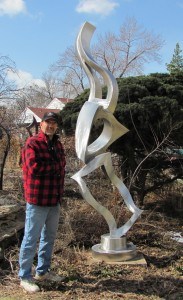www.kevinrobb.com/blog In any study of sculpture there are the 5 basic elements of design that determine the composition of the sculpture: form, scale, color, line and texture. But taking these basic concepts of design one step further is the idea of mass and space. These two principles are at the very core of large scale, contemporary sculpture.
One of the first things a person notices when they encounter a large scale sculpture in a public art arena or a large contemporary sculpture in front of an office building is the massiveness of the piece itself (and just because a sculpture is big doesn’t guarantee it’s a great sculpture!). The materials in the sculpture itself have all the 5 basic elements but it is the mass of the materials that initially draws a person into a contemporary sculpture. From there, the principle of space comes into play. Space is the 3 dimensionality of sculpture and refers to the feeling of depth. Space can be negative or positive. Positive space is the actual space that is occupied by the material. Negative space is the areas surrounding the primary object and often times is just as interesting, if not more, than the positive space itself. A prime example of negative space is the feel and look of the negative spaces created by the flow and juxtaposition of the elements of Kevin Robb’s contemporary sculpt
